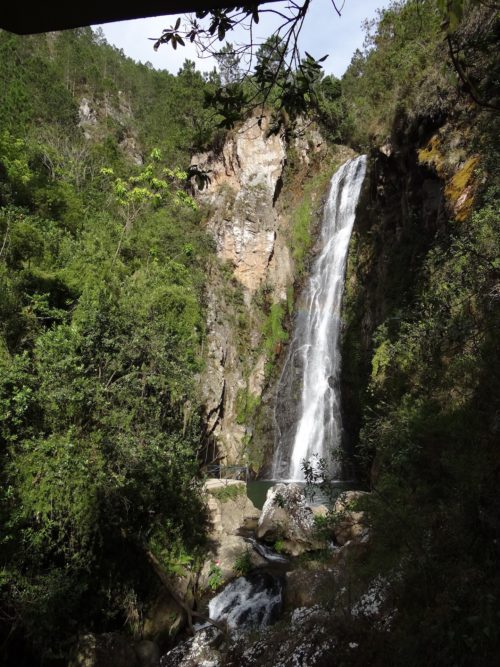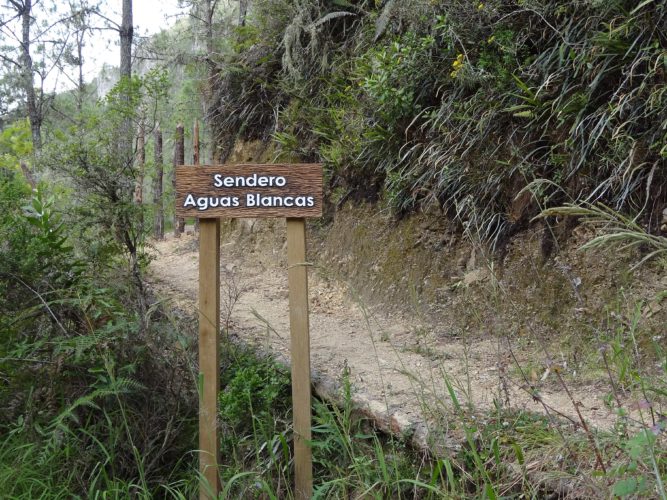Know the Caribbean, Bird by Bird
You are here: Home / Dominican Republic / Central Mountain Range / Constanza and Valle Nuevo
Valle Nuevo National Park (40,900 ha) is a high elevation protected area dominated by cloud forest, grasslands and pine savannas. Situated on a high plateau about 30 kilometers south of Constanza, the reserve is noted for a stone pyramid marking the exact center of Hispaniola. Valle Nuevo embraces the highlands at Alto de la Bandera hill, and is an important catchment area supplying water for the provinces of the northern and southern regions of the Dominican Republic; five river basins resulting in more than 700 rivers have their birth in this area.

Located near the visitor center is a monument called the Pyramids. Once believed to be the center of the island, the structure, in fact, was erected as a token of gratitude to the dictator Rafael Leonidas Trujillo Molina in the construction of the road between San José de Ocoa with Constanza.

Just down the road is another cultural attraction, a mural of Colonel Francisco Caamaño Deño. Deño, former guerilla leader, general, and president, was murdered near here while fighting the regime of President Joaquín Balaguer. He was one of the leaders in the movement to restore the democratically elected President Dr. Juan Bosch, who had been overthrown in a CIA sponsored military coup d’état in September, 1963. He was wounded and captured here by Dominican government forces, and then executed.

Due to the park’s topographical setting, elevation ranges and geological makeup, it provides a high biodiversity of plants and animals. Scientific studies have identified about 531 plant species, which includes 138 species endemic to Hispaniola. More than 145 wildlife species have been identified within the park boundaries, comprised of 66 bird species (18% which are endemic to the Dominican Republic), 17 amphibian species (85% of the represented amphibians in the Central Mountains and 26% of those found in Hispaniola), 29 reptile species (all of which are endemic to Dominican Republic), 33 species of butterflies, and an unreported number of freshwater aquatic species and land snails.

Another attraction within the limits of Valle Nuevo is the Aguas Blancas waterfall. A rural access road (unpaved; four-wheel drive highly necessary) leads directly to the site, which is 17 km from Constanza and about 2 km past the small settlement of El Convento.

The Aguas Blancas waterfall is 83 meters high, in two stages, located at about 1,620 meters above sea level. The falls have become a developed recreation area, with a built infrastructure consisting of restroom facilities, 170 meters of paved trail, two observation platforms, and a small steel footbridge.

The Dominican Republic and United States Agency for International Development (USAID) is currently working on plans for improving the site, which includes interpretive signs and the possible expansion of trails to strengthen the local capacity to monitor and manage this site to ensure safety and its conservation.

There is essentially one main trail at Valle Nuevo. From the entrance you will first encounter fragmented patches of moist broadleaf forest. Here you may find the difficult to see Eastern Chat-tanager and La Selle Thrush. Further along the large open plateau dominates the landscape. This is the main part of the Valle Nuevo National Park and here is where you will find the pyramid. The plateau is not the best place for birdwatching, although you will also find fragments of pine forest here. Look in the pine for such specialties as the Rufous-crowned Sparrow and the Hispaniolan Crossbill.
For bird watching, walking the road in the national park is a great option, as is staying at Villa Pajon and exploring their trails. Other attractions in the park include swimming in the waterfall at Aguas Blancas.
Typical species of the broadleaf forests include the Hispaniolan Parakeet, Hispaniolan Amazon, Golden Swallow, and White-winged Warbler.
Other target species include Sharp-shinned Hawk, Scaly-naped Pigeon, Plain Pigeon, White-fronted Quail-Dove, Ruddy Quail-Dove, White-collared Swift, Hispaniolan Trogon, Rufous-throated Solitaire, Yellow-throated Warbler, Pine Warbler, Hispaniolan Highland-Tanager, Eastern Chat-Tanager, Antillean Siskin, Hispaniolan Spindalis, and Black-faced Grassquit.
Valle Nuevo is located 3.5 – 4 hours from Santo Domingo in the Cordillera Central. To get there you must drive north of Santo Domingo on the Autopista Duarte, the main south-to-north highway. Once you pass the town of Bonao, take the exit to Constanza, after which you will immediately start climbing up a mountain on the Carretera de Casabito. This is a narrow and winding road so proceed with caution. Nearing Constanza, you will again descend into a wide montane valley. Once in Constanza, you will want to turn left toward the Colónia Japonesa and the Carretera de Ocoa. This is a little difficult to find, but ask a local if you are unsure. Follow this road south and back up into the mountains for about 30 kilometers to reach Valle Nuevo.

Access to the park is via an unpaved road from Constanza that will lead you to a gate where you will need to pay an entrance fee of 50 Dominican pesos per person (~$1.30 USD) and 100 Dominican pesos per car. The road then leads you to the Visitor Center and adjacent campground.
The Visitor Center was constructed by Fundación Propagas, an organization that agreed to co-manage the park with the Dominican Ministry of the Environment on May 30, 2012. The Fundación was created in 2007 as the philanthropic arm of the Grupo Propagas company, in order to create and endorse environmental conservation projects. Inside the Visitor Center is lodging for park staff and visiting researchers, as well as a sitting area and interpretive panels. Outside are bathrooms, the campgrounds and protected shelters for cooking.
Villa Pajon is an historic, low-impact eco-lodge located in Valle Nuevo National Park. Its seven comfortably equipped cabins provide the setting to experience this unique landscape. The attentive and accommodating staff facilitates and makes more enjoyable the occasion. Explore this diverse ecosystem, or sit simply sit and enjoy the quiet and unhurried pace of the countryside. Villa Pajon is the ideal place to discover the many possibilities that Valle Nuevo has to offer.

The Barbados-based dynamic birding & #travel experts✈️, Ryan and Alex Chenery of Birding the Islands are crafting tailor-made, multi-island 🏝️ travel itineraries for individuals & small groups. Learn how you can build your own #birding holiday at: bit.ly/Build-your-ow… pic.twitter.com/yEbO…
Endemic Bird of the Day, Day 126! 🦩🦜🦉 The small but feisty Flat-billed Vireo! 🇩🇴🇭🇹 For feathery facts and materials: bit.ly/FlatbilledVir… #CEBF2023 #FromTheNest #WaterSustainingBirdLife @grupojaragua @accionverde @SOSAmbienteRD @TurismoRD @Trees4Haiti @LoopHaiti pic.twitter.com/XwpI…
Join experienced tour guide Ernesto Reyes🇨🇺 on an extraordinary trip to #Colombia! For the detailed itinerary head over to: bit.ly/BirdTourColom… ✨For every BirdsCaribbean person that signs up for this trip, Ernesto will make a $100 donation to us! 📸Carlos Roberto Chavarria pic.twitter.com/Blco…
#ExpeditionDiablotin was a challenging search for the Black-capped Petrel in #Dominica. But also a rewarding experience connecting with locals to build support for its conservation. Learn more at: bit.ly/DiablotinOutr… @ABCbirds @EPICislands @SeabirdEcology @USFWS @jlkbrisbane pic.twitter.com/DBqF…
Endemic Bird of the Day, Day 125! 🦉🦜🦩 A spectacularly colorful Cuban endemic: the Gray-fronted Quail-Dove! 🇨🇺 For feathery facts, puzzles, coloring page & more: bit.ly/GrayFrontedQu… #CEBF2023 #FromTheNest #WaterSustainingBirdLife @BirdingEastCuba @AMA_CUBA pic.twitter.com/WgnQ…